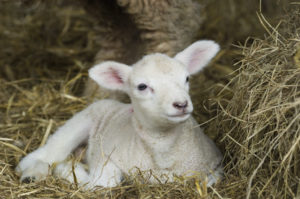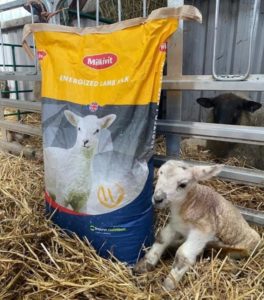For the past 40 years, mortality in small ruminants has stayed the same, with various studies from different countries reporting that 10-35% of lambs die within the first 6 months of life (Yapi et al., 1990, Chaarani et al., 1991, Green & Morgan 1993, Nash et al., 1996). This has an impact on global lamb production and raises welfare considerations. In the UK, the estimated neonatal lamb mortality is 10% (Binns et al., 2002).
There are several factors which can impact the young lamb: from ewe condition and nutrition pre lambing, hygiene, disease, colostrum management, to weather and predators. Knowing these factors as well as reviewing previous and current management regimes to identify any issues will provide the next crop of lambs the best start in life by doing the things which we can control, right!
 The Newborn Lamb
The Newborn Lamb
The lamb is going from a warm and protective environment of the uterus, to a challenging external environment. This could be the snow and rain for those lambing outdoors, or the cooler environment of the lambing shed which can have high disease burdens. During the first 15 minutes of life, the lamb’s internal temperature can drop 1-2⁰C. To compensate for this loss, the lamb will have to increase their heat production by up to 15 times the prenatal level (Eales et al.,1983). Although a major source of energy is brown fat, a newborn lamb has limited reserves of 2-4.5% of their body weight (Sykes, 1982). This highlights the importance of ensuring that enough good colostrum in supporting lamb health, performance and survivability.
Colostrum
Described as liquid gold, colostrum is full of nutrients, fats, protein and minerals (more than what is found in ewe’s milk). Colostrum not only supplies these important goodies, but it also stimulates digestive activity and contains those important immunoglobulins, which support the immune system providing the lamb with important antibodies.
Insufficient intake of colostrum is the second major factor that affects neonatal survival. Lambs require a minimum of 50ml/ kg (of birthweight) of colostrum within the first 2-6 hours, and within 24 hours, lambs should receive 200ml/ kg (of birthweight). As a guide, an optimum birthweight for twins is 4-5kg per lamb (AHDB, 2017). Following colostrum feeding, choice of lamb milk replacer must be considered carefully for artificially reared lambs. To help lambs achieve their full growth potential, and to develop into strong, robust and productive animals the milk replacer should be carefully formulated and digestible to the young animal.
Protein
A key consideration is protein quality; the source of the protein significantly effects digestibility.
Dairy sources such as whey derivatives or skimmed milk are more digestible than vegetable protein sources such as wheat protein, soya bean or pea protein. A high inclusion of protein from dairy sources maximizes digestibility and availability of nutrients, which in turn supports lamb performance. The occurrence of fermentation of undigested nutrients which can cause problems in the digestive tract will also be reduced.
Fat
As previously highlighted, fat is a key component for young lambs. It provides most of the total dietary energy as well as the essential fatty acids. There are 3 main factors which influence the digestibility and absorption of dietary fat, (1) fatty acid profile, (2) triglyceride structure and (3) globule size/structure.
The source and physical structure of the fat are important considerations to optimize the availability of energy to the lamb. Opt for digestible fat sources, such as coconut oil and palm oil which have been homogenised and spray dried to support solubility and stability!
Osmolality (concentration)
Osmolality measures the concentration of the solute particles in a solution and is calculated by adding the concentration of sugars and minerals in mOsm/kg of solvent.
Lamb milk replacers with elevated levels of osmolality can cause damage to gut integrity, increase the risk of abomasal bloat and potentially exacerbate diarrhea severity of sick lambs. Keeping osmolality in mind and choosing a milk replacer which has been carefully formulated will help to reduce this risk of these and promote gut integrity.
Be mindful of mixing rates and milk replacer concentrates- mixing a high concentration level can directly increase the osmolality! Therefore, check feeding instructions, regularly weigh scoops or jugs to ensure concentration are expected and regularly calibrate automatic machines.
For more information on our range of sheep & lamb feeds, or our associated products, call 0800 756 2787 or speak to your local NWF Sales Specialist.
You can also view our sheep feeds and products online HERE.
Read our latest NWF Sheep Bulletin HERE.

